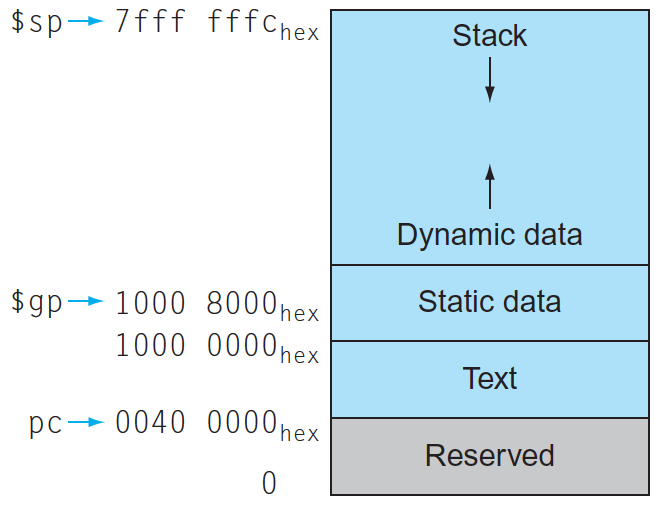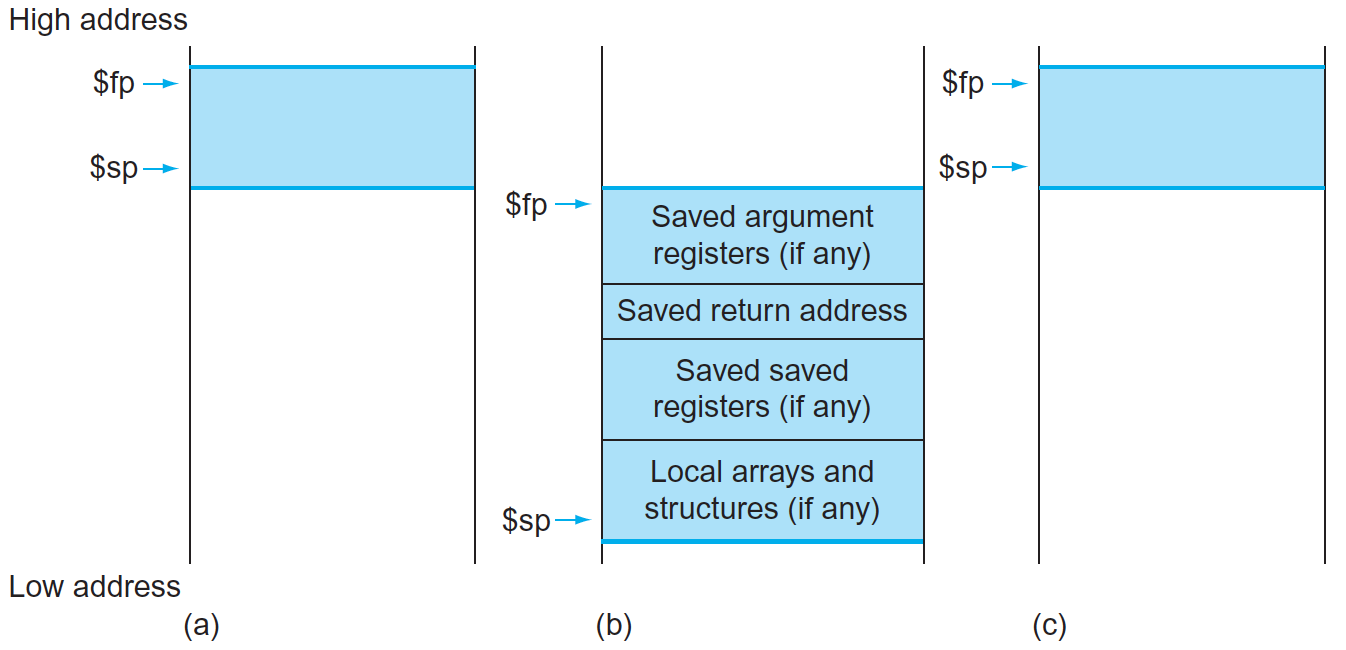# Procedures --- CS 130 // 2024-09-19 <!--=====================================================================--> # Procedures <!-- .slide: data-background="#004477" --> <!--====================================================================--> ### Compile a Simple Leaf Procedure ```python def func(x,y): return x + y ``` --- ```mips func: add $v0, $a0, $a1 jr $ra ``` * the first argument to the procedure is in `$a0` * the second argument to the procedure is in `$a1` * the return value of the procedure goes in `$v0` * `jr`: jump to the instruction whose address is in register `$ra` <!-- .element: class="fragment"--> <!----------------------------------> ```mips func: add $v0, $a0, $a1 jr $ra ``` When you call this function, you must * put the first argument in `$a0` * put the second argument in `$a1` * put the **return address** in `$ra` * jump to the function <!--====================================================================--> ### Calling Our Leaf Procedure ```python def func(x,y): return x + y def main(): func(1, 2) ``` --- ```mips func: add $v0, $a0, $a1 jr $ra main: li $a0, 1 #load the first argument li $a1, 2 #load the second argument jal func ``` `jal`: **jump and link** - put the next instruction's address in `$ra` and jump to the procedure <!-- .element: class="fragment"--> <!----------------------------------> ### Nested Procedure Calls ```python def main(): func(1, func(2, func(3, 4))) ``` --- ```mips main: li $a0, 3 li $a1, 4 jal func li $a0, 2 move $a1, $v0 jal func li $a0, 1 move $a1, $v0 jal func ``` **remember:** `$v0` is where we find the returned value <!-- .element: class="fragment"--> <!--====================================================================--> ## Calling a Procedure 1. Put parameters in appropriate registers + `$a0`, `$a1`, `$a2`, `$a3` 2. Transfer control to the procedure: *jump and link* + `jal ProcedureLabel` - puts the current instruction's address into `$ra` 3. Perform task 4. Place result in a location the callee can find + `$v0`, `$v1` 5. Return control to the caller: *jump to addr. in register* + `jr $ra` <!--====================================================================--> ## Exercise - Convert the following Python code into MIPS - Make sure to create two functions - make sure the print happens in `main`, not `double_it` ```python def double_it(e): return e + e def main(): print( double_it(21) ) ``` <!--====================================================================--> ## Non-Leaf Procedures - Life would be easy if all procedures were "leaves" - In reality, a procedure might call another procedure which may call another procedure ... - could even be *recursive* - <!-- .element: class="fragment"--> We need a way to preserve the state of each partially completed call so that they all return properly <!--====================================================================--> # Stack <!-- .slide: data-background="#004477" --> <!--====================================================================--> ## Stack - MIPS provides a register `$sp` that stores a memory address - <!-- .element: class="fragment"--> Addresses **above** `$sp` is memory that is already being used by other parts of the program - <!-- .element: class="fragment"--> Addresses **below** `$sp` is free memory <!----------------------------------> ## Stack - The **called** procedure is responsible for restoring any saved registers `$s0`, ..., `$s7` as well as the stack pointer `$sp` register before returning - <!-- .element: class="fragment"--> Any other register may be used without restoration, so the **calling** procedure is responsible for saving any data before making the call <!--====================================================================--> ## Memory Structure  <!--====================================================================--> ## Stack Frames  <!--====================================================================--> ## Exercise - Convert the following C code into MIPS ```python def double_it(e): return e + e def calc(c): d = double_it(7) return c + d def main(): a = 5 b = calc(a) ``` <!----------------------------------> ## Exercise Solution: Compute ```python def double_it(e): return e + e ``` ```mips double_it: add $v0, $a0, $a0 # returns e + e jr $ra ``` <!-- .element: class="fragment"--> <!----------------------------------> ## Exercise Solution: Calc - Take 1 ```python def calc(c): d = double_it(7) return c + d ``` ```mips calc: li $a0, 7 # puts 7 in a0 jal double_it # calls compute(7) add $v0, $v0, $a0 # adds argument to result jr $ra ``` <!-- .element: class="fragment"--> - <!-- .element: class="fragment"--> Unfortunately this will fail. Why? + <!-- .element: class="fragment"--> Both `$a0` and `$ra` will be erased! <!----------------------------------> ## Exercise Solution: Calc - Take 2 ```python def calc(c): d = double_it(7) return c + d ``` ```mips calc: addi $sp, $sp, -8 # allocates space sw $a0, 0($sp) # stores c on the stack sw $ra, 4($sp) # stores $ra on the stack li $a0, 7 # puts 7 in a0 jal double_it # calls double_it(7) lw $ra, 4($sp) # restores $ra lw $a0, 0($sp) # restores argument addi $sp, $sp, 8 # deallocates space add $v0, $v0, $a0 # adds argument to result jr $ra ``` <!-- .element: class="fragment"--> <!----------------------------------> ## Exercise Solution: Main ```python def main(): a = 5 b = calc(a) ``` ```mips main: li $s0, 5 # a = 5 move $a0, $s0 # loads a into argument jal calc # calls calc(5) move $s1, $v0 # b = result ``` <!-- .element: class="fragment"--> <!--====================================================================--> ## Assignment - [Assignment 4](../../assignments/assignment-4/) - Translate a Python program that has functions and Arrays - 8 points - Part of it has been done - you'll do a "middle" function.